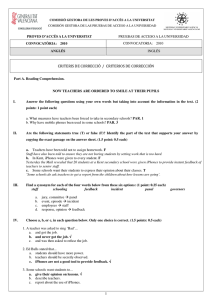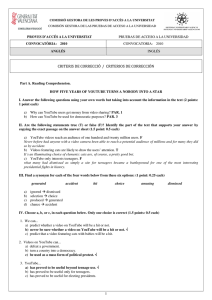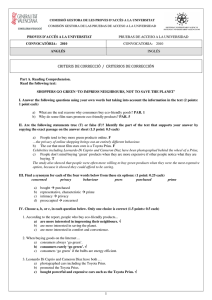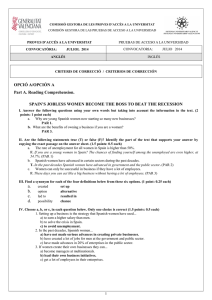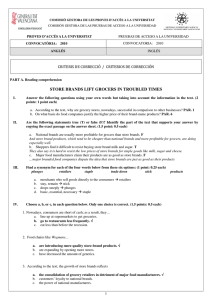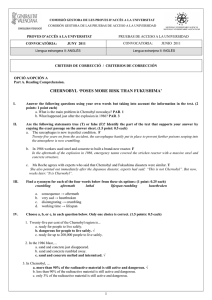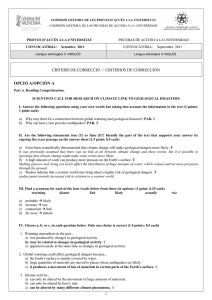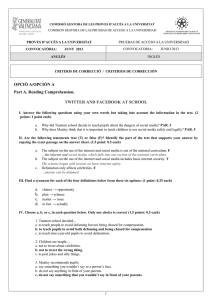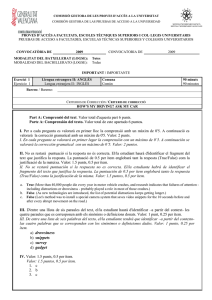Lengua extranjera
Anuncio
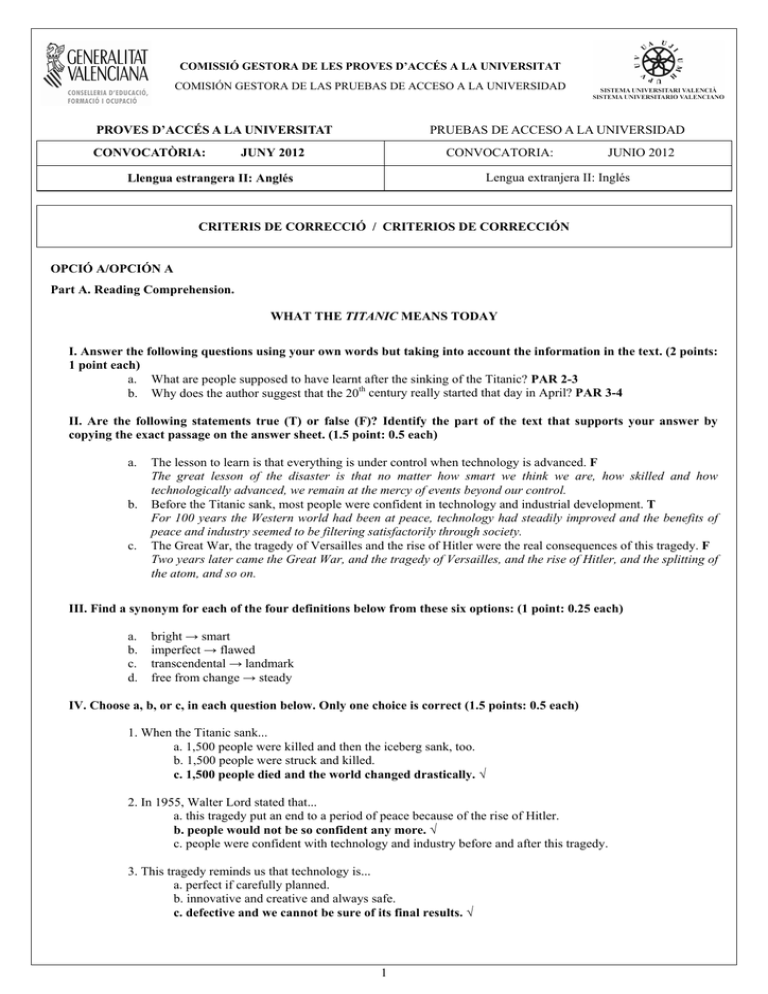
COMISSIÓ GESTORA DE LES PROVES D’ACCÉS A LA UNIVERSITAT COMISIÓN GESTORA DE LAS PRUEBAS DE ACCESO A LA UNIVERSIDAD PROVES D’ACCÉS A LA UNIVERSITAT CONVOCATÒRIA: PRUEBAS DE ACCESO A LA UNIVERSIDAD CONVOCATORIA: JUNY 2012 JUNIO 2012 Lengua extranjera II: Inglés Llengua estrangera II: Anglés CRITERIS DE CORRECCIÓ / CRITERIOS DE CORRECCIÓN OPCIÓ A/OPCIÓN A Part A. Reading Comprehension. WHAT THE TITANIC MEANS TODAY I. Answer the following questions using your own words but taking into account the information in the text. (2 points: 1 point each) a. What are people supposed to have learnt after the sinking of the Titanic? PAR 2-3 b. Why does the author suggest that the 20th century really started that day in April? PAR 3-4 II. Are the following statements true (T) or false (F)? Identify the part of the text that supports your answer by copying the exact passage on the answer sheet. (1.5 point: 0.5 each) a. b. c. The lesson to learn is that everything is under control when technology is advanced. F The great lesson of the disaster is that no matter how smart we think we are, how skilled and how technologically advanced, we remain at the mercy of events beyond our control. Before the Titanic sank, most people were confident in technology and industrial development. T For 100 years the Western world had been at peace, technology had steadily improved and the benefits of peace and industry seemed to be filtering satisfactorily through society. The Great War, the tragedy of Versailles and the rise of Hitler were the real consequences of this tragedy. F Two years later came the Great War, and the tragedy of Versailles, and the rise of Hitler, and the splitting of the atom, and so on. III. Find a synonym for each of the four definitions below from these six options: (1 point: 0.25 each) a. b. c. d. bright → smart imperfect → flawed transcendental → landmark free from change → steady IV. Choose a, b, or c, in each question below. Only one choice is correct (1.5 points: 0.5 each) 1. When the Titanic sank... a. 1,500 people were killed and then the iceberg sank, too. b. 1,500 people were struck and killed. c. 1,500 people died and the world changed drastically. √ 2. In 1955, Walter Lord stated that... a. this tragedy put an end to a period of peace because of the rise of Hitler. b. people would not be so confident any more. √ c. people were confident with technology and industry before and after this tragedy. 3. This tragedy reminds us that technology is... a. perfect if carefully planned. b. innovative and creative and always safe. c. defective and we cannot be sure of its final results. √ 1 Part B. Producció escrita. Valor total d'aquesta part 4 punts. En aquesta part es demana que els alumnes produesquen un text de 130-150 paraules En aquest apartat s'ha de valorar la capacitat de comunicació de l'alumne en un anglès acceptable en expressar la seua opinió i idees sobre aspectes relacionats amb el text proposat. Caldrà valorar quant de positiu haja pogut portar a terme l'alumne i no fixar-se únicament en els errors gramaticals. Seria fonamental considerar els següents aspectes: 1. Aspectes de caràcter estratègic: amb un màxim de 0,5 punts. 2. Correcció gramatical: amb un màxim de 1,5 punts. 3. Claredat d'expressió i organització textual: amb un màxim d'1 punt. 4. Varietat, riquesa i precisió lèxica: amb un màxim d'1 punt. ORIENTACIONS PER A CORRECCIÓ DELS ASPECTES ANTERIORS 1. Aspectes de caràcter estratègic: - Presentació clara i ordenada (marges, sagnats, etc.). - Ortografia correcta. - Text distribuït en paràgrafs. - Ús correcte de signes de puntuació. - Lletra clara i comprensible. - Escrit en tinta. -… 2. Correcció gramatical: - Ordre correcte dels elements fràstics (SVO…). - Concordances correctes (S-V, pronoms referents…). - Formes pronominals correctes. - Quantificadors correctes. - Estructuració negativa correcta. - Temps i seqüències verbals adequats i correctes. - Partícules temporals adequades (FOR, SINCE, AGO, ALREADY). - Ús adequat d'articles (genèrics, específics…). - Ús correcte del possessiu. - Coneixement dels plurals irregulars. - Ús correcte de modals i defectius. - Invariabilitat dels adjectius (gènere i nombre). - Ús correcte de les preposicions. -… 3. Claredat d'expressió i organització textual: - Seqüenciació i organització del text clara i lògica. - No hi ha excessives repeticions. - No és un text confús i fosc. - Ús adequat de connectors per a les diferents idees. - Aproximació al tema coherent i original. - Estructuració de les idees en paràgrafs. -… 4. Varietat, riquesa i precisió lèxica: - No s'usen paraules en espanyol ni inexistents. - Elecció de termes específics i concrets per a aqueix text. - No existeix confusió entre elements lèxics bàsics. - No hi ha confusió entre categories gramaticals. - No existeix un abús desmesurat d'expressions idiomàtiques. Parte B. Producción escrita. Valor total de este apartado 4 puntos. En esta parte se pide que los alumnos produzcan un texto de 130-150 palabras. 2 En este apartado se ha de valorar la capacidad de comunicación del alumno en un inglés aceptable al expresar su opinión e ideas sobre aspectos relacionados con el texto propuesto. Habrá que valorar cuanto de positivo haya podido llevar a cabo el alumno y no fijarse únicamente en los errores gramaticales. Sería fundamental considerar los siguientes aspectos: 1.- Aspectos de carácter estratégico: con un máximo de 0,5 puntos. 2.- Corrección gramatical: con un máximo de 1,5 puntos. 3.- Claridad de expresión y organización textual: con un máximo de 1 punto. 4.- Variedad, riqueza y precisión léxica: con un máximo de 1 punto. - ORIENTACIONES PARA CORRECCIÓN DE LOS ASPECTOS ANTERIORES 1.- Aspectos de carácter estratégico: - Presentación clara y ordenada (márgenes, sangrados etc.) - Ortografía correcta. - Texto distribuido en párrafos. - Uso correcto de signos de puntuación. - Letra clara y comprensible. - Escrito en tinta. -… 2.- Corrección gramatical: - Orden correcto de los elementos frásticos (SVO…) - Concordancias correctas (S-V, Pronombres referentes…) - Formas pronominales correctas - Cuantificadores correctos - Estructuración negativa correcta - Tiempos y secuencias verbales adecuados y correctos - Partículas temporales adecuadas (FOR, SINCE, AGO, ALREADY) - Uso adecuado de artículos (genéricos, específicos…) - Uso correcto del posesivo - Conocimiento de los plurales irregulares - Uso correcto de modales y defectivos - Invariabilidad de los adjetivos (género y número) - Uso correcto de las preposiciones -… 3.- Claridad de expresión y organización textual: - Secuenciación y organización del texto clara y lógica - No hay excesivas repeticiones - No es un texto confuso y oscuro - Uso adecuado de conectores para las diferentes ideas - Aproximación al tema coherente y original. - Estructuración de las ideas en párrafos. -… 4.- Variedad, riqueza y precisión léxica: - No se usan palabras en español ni inexistentes - Elección de términos específicos y concretos para ese texto - No existe confusión entre elementos léxicos básicos - No hay confusión entre categorías gramaticales. - No existe un abuso desmesurado de expresiones idiomáticas. 3 COMISSIÓ GESTORA DE LES PROVES D’ACCÉS A LA UNIVERSITAT COMISIÓN GESTORA DE LAS PRUEBAS DE ACCESO A LA UNIVERSIDAD PROVES D’ACCÉS A LA UNIVERSITAT CONVOCATÒRIA: PRUEBAS DE ACCESO A LA UNIVERSIDAD CONVOCATORIA: JUNY 2012 JUNIO 2012 Lengua extranjera II: Inglés Llengua estrangera II: Anglés CRITERIS DE CORRECCIÓ / CRITERIOS DE CORRECCIÓN OPCIÓ B/OPCIÓN B Part A. Reading Comprehension. CLEANER RUINS 800,000€ ARTWORK THAT SHE THOUGHT WAS DIRTY I. Answer the following questions using your own words but taking into account the information in the text. (2 points: 1 point each) a. Why did the cleaner clean the bucket of the sculpture? PAR.2 b. What happened to Gustav Metzger’s work?PAR.6 II. Are the following statements true (T) or false (F)? Identify the part of the text that supports your answer by copying the exact passage on the answer sheet. (1.5 point: 0.5 each) a. Kippenberger’s sculpture belonged to the Ostwall Museum in Dortmund. F The sculpture by the German artist Martin Kippenberger, widely regarded as one of the most talented artists of his generation until his death in 1997, had been on loan to the Ostwall Museum in Dortmund. b. The cleaner thought Kippenberger’s sculpture needed cleaning. T He thought it was art: the cleaner saw it as a challenge, and set about making the bucket look like new and removed the patina from the four walls of the bucket. c. The spokeswoman told the cleaner to clean the artwork. F Cleaning crews had been told to keep 20cm away from artworks, but it was unclear if the woman had received the memo. III. Find a synonym for each of the four words below from these six options: (1 point: 0.25 each) challenge a. b. c. d. IV. removed failed litter damaged display eliminated → removed deteriorated → damaged rubbish → litter show → display Choose a, b, or c, in each question below. Only one choice is correct. (1.5 points: 0.5 each) 1. Someone told the cleaning crews that... a. they had to keep 20 cm away from artworks. √ b. they all had to keep 20 cm away from artworks except the cleaning woman. c. they had received the memo. 2. Joseph Beuys’ work was worth... a. under 400,000€. b. more than 400,000€. c. around 400,000€. √ 3. In 2004, a cleaner... a. didn’t realise that a plastic bag with discarded paper and cardboard was an artwork. √ b. replaced a plastic bag with another bag. c. displayed an integral part of Recreation of First Public Demonstration of Autodestructive Art. 4 Part B. Producció escrita. Valor total d'aquesta part 4 punts. En aquesta part es demana que els alumnes produesquen un text de 130-150 paraules En aquest apartat s'ha de valorar la capacitat de comunicació de l'alumne en un anglès acceptable en expressar la seua opinió i idees sobre aspectes relacionats amb el text proposat. Caldrà valorar quant de positiu haja pogut portar a terme l'alumne i no fixar-se únicament en els errors gramaticals. Seria fonamental considerar els següents aspectes: 1. Aspectes de caràcter estratègic: amb un màxim de 0,5 punts. 2. Correcció gramatical: amb un màxim de 1,5 punts. 3. Claredat d'expressió i organització textual: amb un màxim d'1 punt. 4. Varietat, riquesa i precisió lèxica: amb un màxim d'1 punt. ORIENTACIONS PER A CORRECCIÓ DELS ASPECTES ANTERIORS 4. Aspectes de caràcter estratègic: - Presentació clara i ordenada (marges, sagnats, etc.). - Ortografia correcta. - Text distribuït en paràgrafs. - Ús correcte de signes de puntuació. - Lletra clara i comprensible. - Escrit en tinta. -… 5. Correcció gramatical: - Ordre correcte dels elements fràstics (SVO…). - Concordances correctes (S-V, pronoms referents…). - Formes pronominals correctes. - Quantificadors correctes. - Estructuració negativa correcta. - Temps i seqüències verbals adequats i correctes. - Partícules temporals adequades (FOR, SINCE, AGO, ALREADY). - Ús adequat d'articles (genèrics, específics…). - Ús correcte del possessiu. - Coneixement dels plurals irregulars. - Ús correcte de modals i defectius. - Invariabilitat dels adjectius (gènere i nombre). - Ús correcte de les preposicions. -… 6. Claredat d'expressió i organització textual: - Seqüenciació i organització del text clara i lògica. - No hi ha excessives repeticions. - No és un text confús i fosc. - Ús adequat de connectors per a les diferents idees. - Aproximació al tema coherent i original. - Estructuració de les idees en paràgrafs. -… 4. Varietat, riquesa i precisió lèxica: - No s'usen paraules en espanyol ni inexistents. - Elecció de termes específics i concrets per a aqueix text. - No existeix confusió entre elements lèxics bàsics. - No hi ha confusió entre categories gramaticals. - No existeix un abús desmesurat d'expressions idiomàtiques. Parte B. Producción escrita. Valor total de este apartado 4 puntos. En esta parte se pide que los alumnos produzcan un texto de 130-150 palabras. 5 En este apartado se ha de valorar la capacidad de comunicación del alumno en un inglés aceptable al expresar su opinión e ideas sobre aspectos relacionados con el texto propuesto. Habrá que valorar cuanto de positivo haya podido llevar a cabo el alumno y no fijarse únicamente en los errores gramaticales. Sería fundamental considerar los siguientes aspectos: 1.- Aspectos de carácter estratégico: con un máximo de 0,5 puntos. 2.- Corrección gramatical: con un máximo de 1,5 puntos. 3.- Claridad de expresión y organización textual: con un máximo de 1 punto. 4.- Variedad, riqueza y precisión léxica: con un máximo de 1 punto. - ORIENTACIONES PARA CORRECCIÓN DE LOS ASPECTOS ANTERIORES 1.- Aspectos de carácter estratégico: - Presentación clara y ordenada (márgenes, sangrados etc.) - Ortografía correcta. - Texto distribuido en párrafos. - Uso correcto de signos de puntuación. - Letra clara y comprensible. - Escrito en tinta. -… 2.- Corrección gramatical: - Orden correcto de los elementos frásticos (SVO…) - Concordancias correctas (S-V, Pronombres referentes…) - Formas pronominales correctas - Cuantificadores correctos - Estructuración negativa correcta - Tiempos y secuencias verbales adecuados y correctos - Partículas temporales adecuadas (FOR, SINCE, AGO, ALREADY) - Uso adecuado de artículos (genéricos, específicos…) - Uso correcto del posesivo - Conocimiento de los plurales irregulares - Uso correcto de modales y defectivos - Invariabilidad de los adjetivos (género y número) - Uso correcto de las preposiciones -… 3.- Claridad de expresión y organización textual: - Secuenciación y organización del texto clara y lógica - No hay excesivas repeticiones - No es un texto confuso y oscuro - Uso adecuado de conectores para las diferentes ideas - Aproximación al tema coherente y original. - Estructuración de las ideas en párrafos. -… 4.- Variedad, riqueza y precisión léxica: - No se usan palabras en español ni inexistentes - Elección de términos específicos y concretos para ese texto - No existe confusión entre elementos léxicos básicos - No hay confusión entre categorías gramaticales. - No existe un abuso desmesurado de expresiones idiomáticas. 6
